The Lord of the Rings: Return of the King
Kristan dreamt he wrote Lord of the Rings last night... turns out he was just Tolkien in his sleep...
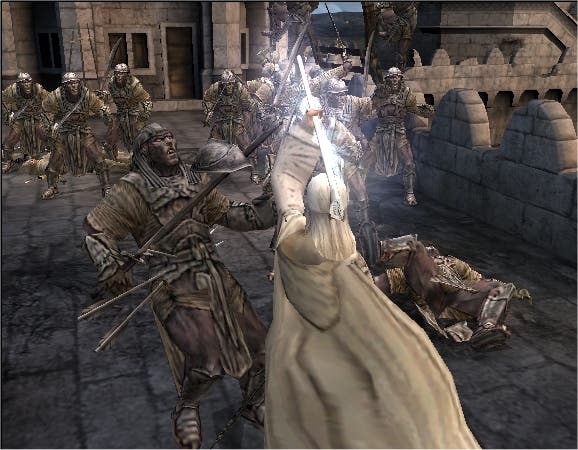
As a game, The Two Towers took a lot of us by surprise. No one seriously expected EA - purveyor of many a movie licence disaster in the past - to produce a title capable of impressing the critics almost as much as the Lord Of The Rings-hungry consumers. In terms of cinematic excellence it broke new boundaries, seamlessly morphing key movie sequences into deliciously rendered real-time hackandslash gaming action that fitted perfectly with the more pacey elements of the film.
At its core it was seemingly no more than a straight-up revival of linear 16-bit hackandslash gaming a la Golden Axe/Final Fight, albeit with elements of Devil May Cry and a rich visual gloss that put it among the best looking games ever made. Although it was a fairly short game with a meagre 12 levels (plus secrets), it was deeper than the button mashing fest initial forays had many believe, with a surprisingly rich RPG upgrade element that encouraged players to unlock an array of new combos with experience points earned for each enemy dispatched. Perhaps the best element for the fans was the ability to play as convincingly recreated versions of all the key stars from the movie, each with their own signature moves that gave the game an immense amount of replayability.
In many ways the game marked crucial turning point in the how to go about successfully capturing the essence of a revered movie, and credit must go to EA for resisting the huge temptation of cashing in on Fellowship's release, holding the game back a year in order to do the license justice. By taking a backwards glance, we've managed to pretty much tell you most of what there is to know about Return Of The King, such are the similarities between the two titles. In essence it's a template game, a case of more of the same with incremental enhancements, so don't go into this expecting any major surprises.
Are you experienced?
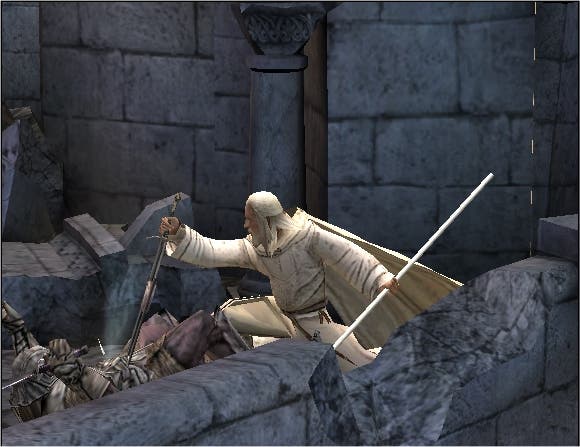
The big draw this time around is undoubtedly the all-important co-op mode, which allows players to pair up from the selection of unlocked characters. Although things do get a tad hectic on-screen at times (actually that's an understatement - it's chaos), and it can be tough to place where your character is among the blur of blades, the mode is a very welcome addition in that any experience you gain within co-op contributes to the character's overall abilities, and vice versa. So, for example, if you've got Gandalf up to level six, you can jump right in a co-op game at the first mission and gain even more experience - maybe giving yourself a better chance of getting past whatever mission you're stuck on, which gives an extra incentive to play with a mate.
Typically, though, there are the inevitable occasions when both players try and engage in a tug-of-war by going in opposite directions, but otherwise only a rare but noticeable drop in the frame rate mars this excellent addition to the game; maybe in the future they can go the whole hog and make it four player co-op, Gauntlet-style.
The other key enhancement is the ability to interact with the scenery on a far deeper level. Some are essential, such as pulling a lever to lower a drawbridge, while others rain chaos and death down on your adversaries and act as a cunning and spectacular combat shortcut rather than an essential part of the level completion. Elsewhere, you'll be kicking ladders, throwing flaming spears or climbing ropes and many other context-sensitive one-offs, and it all ups the cinematic quotient considerably.
Outside of this, though, the core gameplay remains pretty much unchanged; the basic tree like structure of the level progression and the game mechanics themselves are nigh on identical to the original, and likewise, the controls, visuals and sounds will all be familiar to those who've experienced The Two Towers, but when it's as slick and enjoyable as this, maybe that's only to be expected. However the casual LOTR fans that already own TTT might find themselves needing more than the repeat prescription ROTK provides.
Don't stop the hack
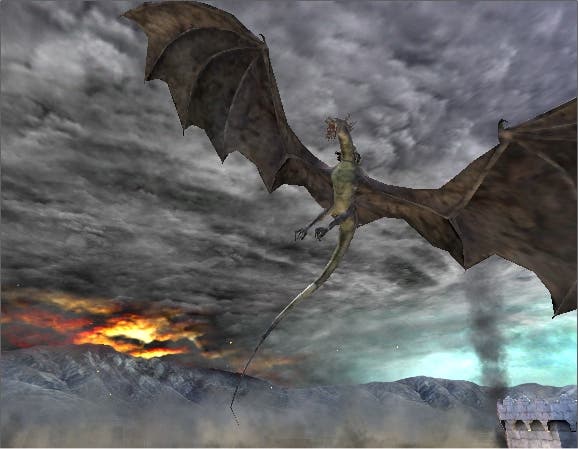
Newcomers, or those in love with the original, however, are in for a dose of non-stop, masterfully presented action that definitely gets better the more you play it. Once again, the game throws up a limited choice of characters to play as in the first instance. The first mission serves as no more than a throwaway tutorial/refresher, with Gandalf dishing out his special brand of wizardry to a bunch of slavering minions, but beyond that the game opens up as a three-way split; the path of the Wizard (Gandalf), The Path Of The King (Two Towers-style Aragorn, Legolas and Gimli), and The Path Of The Hobbits (Sam and, once unlocked, Frodo).
Once you've completed all 12 main missions there's a final duke out in the Crack Of Doom (can't resist a snigger at this point, apologies), but in-between you can attempt each branch in the order of your choosing, even going back to earlier missions if you feel like you need an upgrade or two to attempt the trickier sections. This certainly came in useful on the numerous occasions we became hopelessly overwhelmed by our abject lameness; limiting the frustration factor of being completely stuck. It's also a bonus that you can adjust the difficulty level whenever you like - something other games would benefit from.
In order to truly get the most out of the game, it's a fundamental requirement to learn the subtleties of the combat, and how best to deal with each enemy. For the first couple of levels in each 'tree', the chances are you'll be able to get by just mashing buttons like an amphetamine addled psycho, but if you try and persist in this fashion the game throws up a very large 'none shall pass' message in the form of innumerable deaths, and a fair dose of frustration.
Finish him!
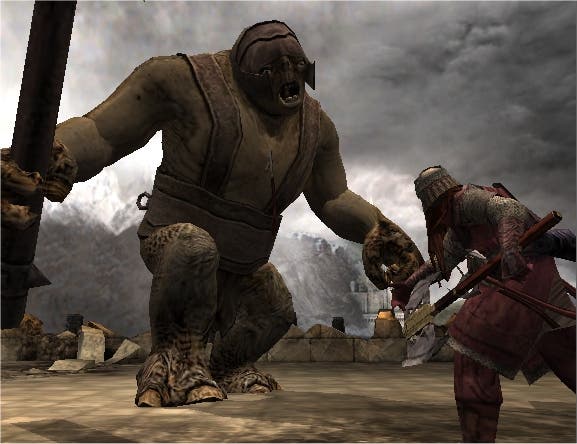
As with TTT, the controls are pretty basic initially, with just a handful of moves available; a fast slashing attack, parry, kick, heavy attack, a finishing move for downed foe, plus a projectile attack. But you'll quickly augment these moves with a series of progressively more complicated combos, which you can effectively purchase between levels with any experience you've gained from your monster mash.
How much experience you gain depends on how ferocious and quick your combat becomes; at the low end a downed enemy will earn you a 'fair' rating, right up to 'perfect' for the elite players. Unlike the Devil May Cry model, this isn't some arbitrary measure of 'style', but a genuine reflection of your skill and speed. A simple blow will only provide a small boost to your combat meter, and unless you follow it up, it will drop to nothing again. But if you manage a chain of quick blows or blocks, your meter will shoot up from fair to good to excellent, before eventually entering the 'Perfect' mode, meaning kills will earn you more even more experience, and thus you can unlock more moves and upgrade yourself quicker.
The end of mission rating also has a bearing on what you can or can't access, so while completing it will unlock the next in that branch, merely getting a 'fair' assessment won't help you unlock the many characters available to you. But in a game as crammed with enticing set-pieces as this, you won't mind the occasional bit of back-tracking to level up your character, and in fact the more abilities you have at your disposal, the more fun it gets. Until you learn its intricacies, you're simply scratching the surface of what can be a superbly enjoyable hackandslasher. Until the game actually demands you to learn the combat manoeuvres properly, it can seem like an incredibly shallow experience that exists just to show off some fancy effects from an array of beautiful, but totally unhelpful camera angles.
It's our old friend, the camera issue
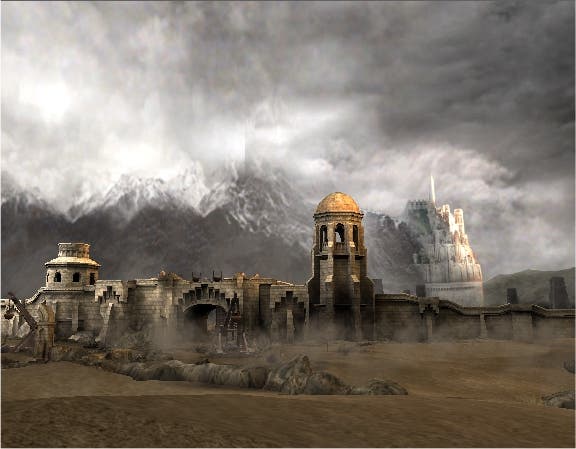
At times we were left cursing at the way the game designers have spent more time pissing about with the undoubtedly spectacular cinematics than worrying about how the player copes with camera switches which reverse the controls, or worse, completely obscure your viewpoint. On just about every mission the camera switching confuses the hell out of you, and some kind of optional overhead map facility would have been immensely useful helping players to get their bearings. As it is, you'll be forced into multiple restarts until you finally get to grips with the layout - witness the Gandalf level where he's tasked with defending the castle ramparts from a sea of Orc invaders. It's almost ludicrously unhelpful, no matter how beautiful the results are, and sometimes you simply lose track of where the hell you are, there's so many characters on screen at once.
Speaking of which, the visuals are truly jaw dropping at times, and do a magnificent job of bringing Middle Earth to life. The level of detail is often staggering, with exquisite texturing, moody lighting, dense mist and a constant backdrop of chaos going on all around you from all manner of extremely detailed and well animated foes. We'd be hard pressed to think of a better looking game on the PS2, although the absence of widescreen support is something of an annoyance, and a rare omission by EA. Frame rate wise, the game has a few problems on the PS2, so if you have the choice you're better off with the Cube, PC or Xbox version - particularly the latter two with glorious 5.1 support.
And on that note, the audio is similarly in the upper echelons, with THX support helping to blast out a constant rabble of screaming Orc-fuelled battle ambience superbly well, along with regular scripted one-liners from the real-life voice actors and a typically grandiose Howard Shore score to match. Another nice touch is the return of the extras, which are unlocked with the completion of a level and feature all the main actors talking about their experiences with the game (and showing off their real hairstyles, rather disturbingly!). Seemingly, most of them are actually don't care or are quite crap at games, so it smacks a little of contractual obligation. Still, nice of them to show up for the fans.
What, no online?
One surprising omission from the PAL version is the ability to play two-player co-op online with USB headset support. Quite why this was stripped out when FIFA, SSX 3 and Rising Sun are all online over here is anyone's guess. Essentially it allows you to play any opponent on any level you've unlocked - even if they haven't, so we're really quite peeved this has been removed. Call EA and vent your displeasure!
As a piece of digital merchandise, they simply don't come any more authentic and lavish than ROTK. The fact that it stacks up as a decent game in its own right is definitely a bonus; it's a surprisingly deep, involving and intense hackandslash experience that belies its apparent simplicity. Sure, it's no RPG, it's not an especially big game, but it doesn't outstay its welcome either. All told, EA succeeds in delivering the brand in unprecedented style to a mass market audience while simultaneously managing to keep the hardcore fans and the core gamer onside - a perilously tricky balancing act by all accounts. On the downside, the unwary traveller should be warned that the camera angles will frustrate and delight in equal measures, and that - co-op aside - the new additions are at a premium. The other main thing to consider is that TTT is now available at half the price. Is it worth paying full whack for this? If you're a fan, most certainly. If not, the wait for its Platinum release will be well worth it.

